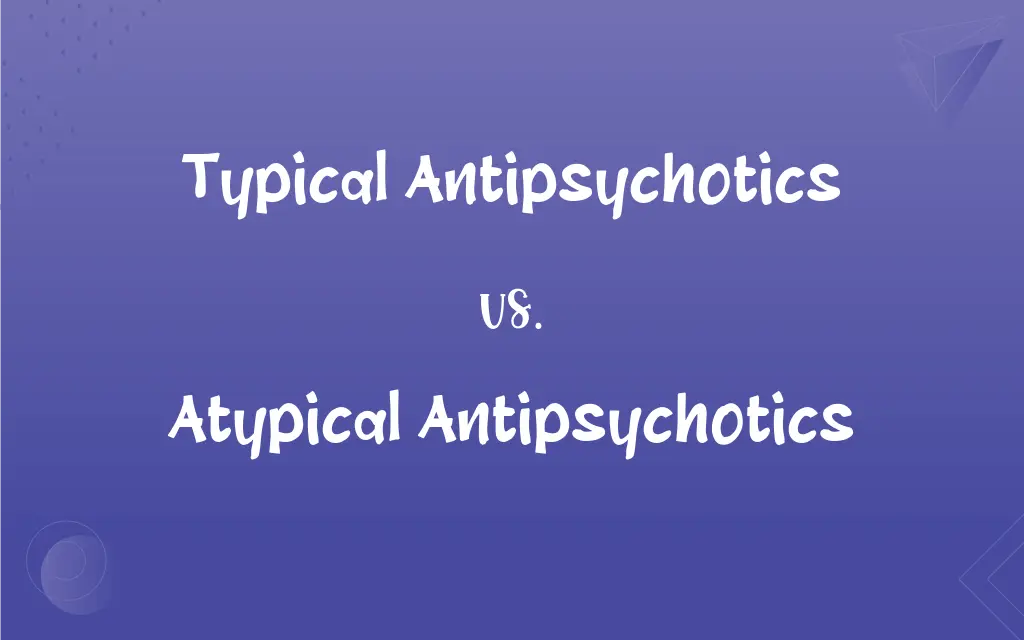Typical Antipsychotics vs. Atypical Antipsychotics: What's the Difference?
Edited by Aimie Carlson || By Harlon Moss || Updated on October 30, 2023
Typical antipsychotics primarily target dopamine receptors and were the first generation of antipsychotic drugs, while atypical antipsychotics affect multiple neurotransmitters and represent the newer generation with fewer motor side effects.

Key Differences
Typical antipsychotics are often referred to as first-generation antipsychotics. They primarily work by blocking dopamine receptors in the brain, which can help reduce symptoms of schizophrenia and other psychotic disorders. On the other hand, atypical antipsychotics are also known as second-generation antipsychotics. They not only act on dopamine receptors but also on serotonin receptors, providing a broader mechanism of action.
In terms of side effects, typical antipsychotics are known to cause extrapyramidal symptoms, which are motor-related side effects such as tremors, rigidity, and tardive dyskinesia. These side effects can be quite distressing to patients. In contrast, atypical antipsychotics generally have a lower risk of these motor side effects, which is one of the reasons they are often preferred in modern clinical practice.
However, atypical antipsychotics are not without their own set of side effects. They can lead to metabolic disturbances, including weight gain, diabetes, and increased cholesterol. Typical antipsychotics, while having motor side effects, generally have a lower risk of these metabolic issues.
Both typical antipsychotics and atypical antipsychotics serve as crucial tools in the management of psychotic disorders. The choice between them depends on the individual patient's needs, the side effect profile that is deemed acceptable, and the specific symptoms being targeted. While atypical antipsychotics are often chosen for their favorable side effect profile, typical antipsychotics still play a role, especially when cost or specific symptomatology is a concern.
Comparison Chart
Generation
First-generation
Second-generation
ADVERTISEMENT
Primary Action
Dopamine receptor antagonists
Dopamine and serotonin receptor antagonists
Common Side Effects
Extrapyramidal symptoms
Metabolic disturbances
Risk of Motor Side Effects
Higher
Lower
Treatment of Negative Symptoms
Less effective
More effective
Typical Antipsychotics and Atypical Antipsychotics Definitions
Typical Antipsychotics
Typical antipsychotics are known for their risk of causing motor side effects.
Long-term use of typical antipsychotics can lead to tardive dyskinesia in some patients.
ADVERTISEMENT
Atypical Antipsychotics
Atypical antipsychotics can treat both positive and negative symptoms of schizophrenia.
The ability of atypical antipsychotics to address negative symptoms like apathy makes them versatile in treatment.
Typical Antipsychotics
Typical antipsychotics have been in use longer than their atypical counterparts.
Before the introduction of atypical antipsychotics, typical antipsychotics were the primary treatment for psychotic disorders.
Atypical Antipsychotics
Atypical antipsychotics can lead to metabolic side effects, including weight gain.
Patients on atypical antipsychotics often require monitoring for metabolic changes, such as increased blood sugar.
Typical Antipsychotics
Typical antipsychotics mainly target the dopamine pathways in the brain.
By blocking dopamine receptors, typical antipsychotics can help reduce psychotic symptoms.
Atypical Antipsychotics
Atypical antipsychotics have a broader mechanism of action, including serotonin receptor antagonism.
The dual action on dopamine and serotonin receptors gives atypical antipsychotics a unique therapeutic profile.
Typical Antipsychotics
Typical antipsychotics are first-generation drugs primarily blocking dopamine receptors.
Haloperidol is a commonly used typical antipsychotic for treating schizophrenia.
Atypical Antipsychotics
Atypical antipsychotics generally have fewer motor-related side effects than typical ones.
Due to their better side effect profile, atypical antipsychotics are often preferred for long-term treatment.
Typical Antipsychotics
Typical antipsychotics are often cheaper than atypical ones.
Due to their long history of use, many typical antipsychotics are available as generics, making them more affordable.
Atypical Antipsychotics
Atypical antipsychotics are second-generation drugs affecting multiple neurotransmitters.
Risperidone is an atypical antipsychotic used in the treatment of bipolar disorder and schizophrenia.
FAQs
What are typical antipsychotics primarily used for?
Typical antipsychotics are primarily used to treat schizophrenia and other psychotic disorders.
Why are atypical antipsychotics often preferred today?
Atypical antipsychotics are preferred due to their broader mechanism of action and a better side effect profile.
Are there side effects associated with atypical antipsychotics?
Yes, atypical antipsychotics can cause metabolic side effects, such as weight gain and increased cholesterol.
Can atypical antipsychotics be used in depression?
Some atypical antipsychotics are approved as adjunctive treatments for depression when other treatments don't work.
Why is monitoring required with atypical antipsychotics?
Due to risks like weight gain and diabetes, regular health monitoring is essential with atypical antipsychotic use.
Are there any non-schizophrenia conditions treated by typical antipsychotics?
Yes, some typical antipsychotics might be used for conditions like severe anxiety or agitation.
Do all patients on typical antipsychotics develop motor side effects?
No, not all patients will develop these side effects, but the risk is higher compared to atypical antipsychotics.
Can children be prescribed atypical antipsychotics?
Some atypical antipsychotics have pediatric indications but should be used cautiously, considering potential side effects.
Are all typical antipsychotics the same?
No, while they share a primary mechanism of action, individual typical antipsychotics can have different properties and side effects.
Can typical antipsychotics cause tardive dyskinesia?
Yes, long-term use of typical antipsychotics can lead to tardive dyskinesia, a movement disorder.
Why are some typical antipsychotics available as injectables?
Injectable forms allow for longer durations between doses, useful for patients with adherence issues.
Is weight gain a common side effect with atypical antipsychotics?
Yes, many atypical antipsychotics can lead to significant weight gain.
Are typical antipsychotics obsolete?
No, while atypical antipsychotics are often preferred, typical ones are still used based on individual patient needs and cost considerations.
Are there any natural alternatives to typical and atypical antipsychotics?
While some might turn to natural remedies, no natural alternative has been proven as effective as prescription antipsychotics. Always consult a doctor before making medication decisions.
Which antipsychotic type is known for causing motor side effects?
Typical antipsychotics have a higher risk of causing motor side effects like tremors.
Which antipsychotic type is better for treating negative symptoms of schizophrenia?
Atypical antipsychotics are generally more effective in treating negative symptoms compared to typical antipsychotics.
Can atypical antipsychotics treat bipolar disorder?
Yes, some atypical antipsychotics are approved for treating manic and mixed episodes in bipolar disorder.
Which is more expensive, typical or atypical antipsychotics?
Generally, atypical antipsychotics are more expensive, especially brand-name versions.
How do atypical antipsychotics differ from typical ones in mechanism?
Atypical antipsychotics act on both dopamine and serotonin receptors, while typical ones primarily target dopamine receptors.
Do atypical antipsychotics have a faster onset of action?
Not necessarily; the onset of action depends on the specific drug and the condition being treated.
About Author
Written by
Harlon MossHarlon is a seasoned quality moderator and accomplished content writer for Difference Wiki. An alumnus of the prestigious University of California, he earned his degree in Computer Science. Leveraging his academic background, Harlon brings a meticulous and informed perspective to his work, ensuring content accuracy and excellence.
Edited by
Aimie CarlsonAimie Carlson, holding a master's degree in English literature, is a fervent English language enthusiast. She lends her writing talents to Difference Wiki, a prominent website that specializes in comparisons, offering readers insightful analyses that both captivate and inform.































































